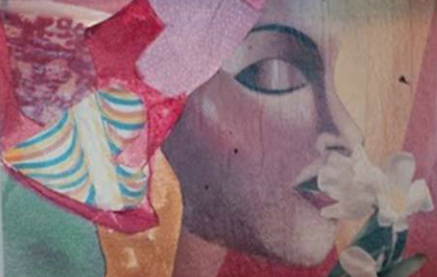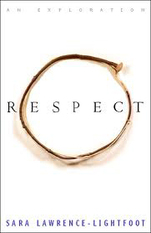Portraits
Portrait of an Institution
Intimate Portrait Human Archaeology Portrait of a Concept Portrait of a Relationship Portrait of a Developmental Stage Portrait of a Process Portrait of a Concept
[Artist: Tolani Lawrence-Lightfoot (2001)] My interest in exploring the underlying nature of respect is motivated by more than personal memories. I am also drawn to the concept because it holds increasing importance for public and private life today. When we worry about the deterioration of civility, street violence, the lack of decorum and safety in schools, the invasions of privacy by the press, harassment in the workplace, and the dirty language and offensive gestures that fill our daily encounters, we often cite lack of respect as the reason that our social fabric is tearing. Likewise, when we suffer the private assaults of infidelity, emotional and physical abuse, even misunderstanding and isolation, we often see the roots of the pain as originating in disrespectful attitudes and behavior. Every morning the newspaper contains a story that echoes the words of Aretha’s anthem: pleas for respect from people who have been violated, neglected, or ignored by loved ones, acquaintances, strangers, or public figures. Courts are filled with juveniles who have been thrown out of their homes and cast out of school for their delinquent behavior. The judge may or may not give them time in juvenile detention, but she will almost always give them a sermon on respect. In September, in almost every classroom across the country, teachers begin the year with admonitions and rituals that have respect as their central message. And parents lament the ways in which their offspring do not show them respect that they remember giving to their parents when they were young. Most of these references to respect—both public and private—are warnings about the catastrophic consequences that result when it is absent. We pay more attention to it when it is not expressed. But complaints about the loss of civility or the disrespectful attitudes that characterize contemporary society raise two questions. First of all, it is hard to know what is being used to measure the degree to which things are truly worse. Has there been a real and measurable deterioration of respect, or are we simply hearing the lament voiced by every generation as it confronts a reality so different from its own past, change that feels ominous and frightening? When we reach adulthood, do we put on the rosy glasses of nostalgia, conjuring up a time when parents had authority and children were respectful; when teachers were strict and their students obeyed? One of my colleagues, Joseph Featherstone, a social historian, claims—only half-jokingly—that adults in our society suffer from “A History of Amnesia,” a profound ahistoricism that tends to romanticize the past and denigrate the present. We reminisce about a world that was safe and stable and civilized—when you could trust your neighbor, ride the subways at night with no fear, and believe what your children told you—all the while forgetting or ignoring the facts of the past, which, of course, included incidences of betrayal, crime, and deception. Undoubtedly, our stories express a complex of feelings, some rooted in real lived experiences, and others filtered through the haze of nostalgia. The other, perhaps more interesting, question raised by our laments about the absence of respect in relationships, in the workplace, or in political life has to do with what we mean by the term. Although our views are no doubt both fluid and hybrid, traditional conceptions of respect still have a potent influence on the ways we judge our society. Respect is commonly seen as deference to status and hierarchy; as driven by duty, honor, and a desire to avoid punishment, shame, or embarrassment. Often our view does not involve individuals, as in “respect for property,” for the law, the flag, or institutions. In many contemporary cultural views—calls for more respectful relationships in health care, urban planning, education, or the more strident calls for a civil society—we do not hear the voices of individuals; neither do we see any recognition of the painstaking work involved in nourishing respectful relationships. The traditional view of respect, though rarely expressed in its pure form, tends to be relatively static and impersonal. The remnants of this view survive today and shape our expectations, our apprehensions, and our disappointments. In this book, I hope to shape a new view of respect. Usually, respect is seen as involving some sort of debt due people because of their attained or inherent position, their age, gender, class, race, professional status, accomplishments, etc. Whether defined by rules of law or habits of culture, respect often requires expressions of esteem, approbation, and submission. By contrast, I focus on the way respect creates symmetry, empathy, and connection in all kinds of relationships, even those, such as teacher and student, doctor and patient, commonly seen as unequal. Rather than looking for respect as a given in certain relationships, I am interested in watching it develop over time. I see it not only as an expression of circumstance, history, temperament, and culture, rooted in rituals and habits, but also arising from efforts to break with routine and imagine other ways of giving and receiving trust, and in so doing, creating relationships among equals. Respectful relationships also have a way of sustaining and replicating themselves. I would like to document how respect grows, the dynamic interactions that create and sustain the respect. Respect generates respect; a modest loaf becomes many. With that in mind, this book examines how people work to challenge and dismantle hierarchies rather than how they reinforce and reify them, as well as the ways in which the context—the situation of healer and patient, teacher and student, photographer and subject—shapes the ways in which people engage in respectful relationships. Since the focus here will be on individuals, it is important to consider how family roots, temperament, and life stories shape the ways in which they are able to become respectful and respected. Rather than the language of inhibition and constraint typical of a more old-fashioned view of respect, the voices in this volume are ones of challenge and exuberance. Rather than the language of dutiful compliance, we will hear words of desire and commitment. In Respect, I emphasize relationships that are asymmetric; relationships that are characterized by contrasts in power, knowledge, and control between the participants. The more powerful persons in these relationships—the experts, the witnesses, the knowledge bearers—are those usually seen as on the receiving end of respect. The people whose voices you hear and whose actions you see, however, each believe that it is impossible to do the work that they do without offering respect, creating a relationship with respect at the center. I purposely chose people, both black and white, who are articulate about the ways in which respect defines the character of their work. In each of the six chapters of the book, I watch respect developing over time, sustained by past experience and continually reinvented in the present. Each chapter focuses on a different setting, from a childbed to a deathbed, from a studio to a law school lecture. Most important, I have sought, through each person’s story, to reveal one crucial dimension of the term. With these six facets, or sources of illumination, I try to portray the many-splendored quality that we call respect. Six windows on respect—empowerment, healing, dialogue, curiosity, self-respect, and attention—each one reveals a different angle of vision; each one illuminates different experiences. As I listen to these storytellers and observe them in action, I bring my own voice to the mix, echoing with my own history and associations and underlying the dimensions we explore. I also bring these voices together both in harmony and counterpoint, creating moments of dissonance and resolution that sharpen our understanding of the six forms of respect. As I talk with these teachers and healers, I feel as though we are in a hall of mirrors, seeing ourselves reflected in each other’s eyes, hearing our conversations echoed in their stories. In order for us to explore the rich phenomenon of respect, we must ourselves engage in respectful dialogue, one built on relationships that move toward symmetry and intimacy. Our dialogue captures our full attention, allows us to take risks, explores silences, and challenge our inhibitions. The attentive, healing power of such a relationship, the life-enhancing glow of respect given and gained, is an experience I would wish for all my readers.
|




